Weak Gravitational Lensing around Bardeen Black Hole with a String Cloud in the Presence of Plasma
Abstract
:1. Introduction
2. Bardeen Spacetime with a Cloud of Strings
3. Weak Gravitational Lensing with Plasma
3.1. Uniform Plasma with
3.2. Non-Uniform Plasma with Singular Isothermal Sphere Medium
3.3. -
4. Magnification of Image Source in the Presence of Plasma
4.1. Uniform Plasma with
4.2. Non-Uniform Plasma with SIS Medium
5. Conclusions
- We analyzed the horizon radius for various values of the black hole in Bardeen gravity with a cloud string parameter a. The results show that the radius of horizon is decreasing in the presence of parameter q, and the effect of string clouds is inverse.
- In the presence of the parameter a and magnetic charge q of the Bardeen spacetime metric with a cloud of a string field, the deflection angle of light beams around the BH decreases. In addition, with fixed values of the magnetic charge q and parameter a, the influence of uniform plasma on the gravitational weak deflection angle is also shown in Figure 3.
- As seen in Figure 4, the deflection angle of light rays around the compact object increases as the value of the parameter responsible for the non-uniform plasma medium increases.
- The deflection angle of a light beam around the BH is larger in the uniform case than in the non-uniform case, and this is true regardless of the values of the parameters a and q in the plasma (Figure 6).
- For various values of the parameter a and magnetic charge q in Bardeen spacetime in the presence of a cloud string field, we have explored the overall magnification of the image source caused by gravitational weak lensing. We have demonstrated that the magnetic charge has an impact on the total magnification of the image but that the total magnification also increases with an increase in the parameter a (see Figure 8 and Figure 9).
- Finally, we have investigated the total magnification’s reliance on the plasma medium and found that it increases as the plasma medium’s uniform and non-uniform properties are increased.
Author Contributions
Funding
Institutional Review Board Statement
Informed Consent Statement
Data Availability Statement
Acknowledgments
Conflicts of Interest
References
- Hawking, S.W. Black hole explosions? Nature 1974, 248, 30–31. [Google Scholar] [CrossRef]
- Born, M.; Infeld, L. Foundations of the New Field Theory. Proc. R. Soc. Lond. A 1934, 144, 425–451. [Google Scholar] [CrossRef]
- Hendi, S.H.; Panahiyan, S.; Eslam Panah, B. Geometrical method for thermal instability of nonlinearly charged BTZ Black Holes. arXiv 2015, arXiv:1509.07014. [Google Scholar] [CrossRef] [Green Version]
- Dehghani, M. Thermodynamics of (2 + 1)-dimensional charged black holes with power-law Maxwell field. Phys. Rev. D 2016, 94, 104071. [Google Scholar] [CrossRef]
- Dehghani, M.; Hamidi, S.F. Thermal stability analysis of nonlinearly charged asymptotic AdS black hole solutions. Phys. Rev. D 2017, 96, 044025. [Google Scholar] [CrossRef]
- Bardeen, J.M. Non-singular general-relativistic gravitational collapse. In Proceedings of the International Conference GR5, Tbilisi, Georgia, 9–16 September 1968; p. 174. [Google Scholar]
- Ayón-Beato, E.; García, A. The Bardeen model as a nonlinear magnetic monopole. Phys. Lett. B 2000, 493, 149–152. [Google Scholar] [CrossRef] [Green Version]
- Rodrigues, M.E.; Junior, E.L.B.; Silva, M.V.d.S. Using dominant and weak energy conditions for build new classe of regular black holes. JCAP 2018, 2018, 59. [Google Scholar] [CrossRef] [Green Version]
- Dymnikova, I. Regular electrically charged vacuum structures with de Sitter centre in nonlinear electrodynamics coupled to general relativity. Class. Quantum Gravity 2004, 21, 4417–4428. [Google Scholar] [CrossRef]
- Rodrigues, M.E.; Silva, M.V.d.S. Bardeen regular black hole with an electric source. JCAP 2018, 2018, 025. [Google Scholar] [CrossRef] [Green Version]
- Bambi, C.; Modesto, L. Rotating regular black holes. Phys. Lett. B 2013, 721, 329–334. [Google Scholar] [CrossRef] [Green Version]
- Eiroa, E.F.; Sendra, C.M. Gravitational lensing by a regular black hole. Class. Quantum Gravity 2011, 28, 085008. [Google Scholar] [CrossRef] [Green Version]
- Zhou, S.; Chen, J.; Wang, Y. Geodesic Structure of Test Particle in Bardeen Spacetime. Int. J. Mod. Phys. D 2012, 21, 1250077. [Google Scholar] [CrossRef] [Green Version]
- Moreno, C.; Sarbach, O. Stability properties of black holes in self-gravitating nonlinear electrodynamics. Phys. Rev. D 2003, 67, 024028. [Google Scholar] [CrossRef] [Green Version]
- Sharif, M.; Javed, W. Quantum Corrections for a Bardeen Regular Black Hole. J. Korean Phys. Soc. 2010, 57, 217. [Google Scholar] [CrossRef] [Green Version]
- Chirenti, C.; Saa, A.; Skákala, J. Quasinormal modes for the scattering on a naked Reissner-Nordström singularity. Phys. Rev. D 2012, 86, 124008. [Google Scholar] [CrossRef] [Green Version]
- Joshi, P.S.; Malafarina, D.; Narayan, R. Distinguishing black holes from naked singularities through their accretion disc properties. Class. Quantum Gravity 2014, 31, 015002. [Google Scholar] [CrossRef]
- Tsukamoto, N. Gravitational lensing by a photon sphere in a Reissner-Nordström naked singularity spacetime in strong deflection limits. Phys. Rev. D 2021, 104, 124016. [Google Scholar] [CrossRef]
- Gürses, M.; Gürsey, F. Derivation of the string equation of motion in general relativity. Phys. Rev. D 1975, 11, 967–969. [Google Scholar] [CrossRef] [Green Version]
- Gürses, M.; Gürsey, F. Lorentz covariant treatment of the Kerr-Schild geometry. J. Math. Phys. 1975, 16, 2385–2390. [Google Scholar] [CrossRef] [Green Version]
- Stachel, J. String matter: Perfect dust and hydrodynamics. In Proceedings of the General Relativity and Gravitation 1977, Waterloo, NSW, Canada, 7–13 August 1977; p. 324. [Google Scholar]
- Letelier, P.S. Clouds of strings in general relativity. Phys. Rev. D 1979, 20, 1294–1302. [Google Scholar] [CrossRef]
- Herscovich, E.; Richarte, M.G. Black holes in Einstein-Gauss-Bonnet gravity with a string cloud background. Phys. Lett. B 2010, 689, 192–200. [Google Scholar] [CrossRef] [Green Version]
- Graça, J.P.M.; Salako, G.I.; Bezerra, V.B. Quasinormal modes of a black hole with a cloud of strings in Einstein-Gauss-Bonnet gravity. Int. J. Mod. Phys. D 2017, 26, 1750113. [Google Scholar] [CrossRef] [Green Version]
- Ghosh, S.G.; Papnoi, U.; Maharaj, S.D. Cloud of strings in third order Lovelock gravity. Phys. Rev. D 2014, 90, 044068. [Google Scholar] [CrossRef] [Green Version]
- Ghosh, S.G.; Maharaj, S.D. Cloud of strings for radiating black holes in Lovelock gravity. Phys. Rev. D 2014, 89, 084027. [Google Scholar] [CrossRef] [Green Version]
- Mustafa, G.; Atamurotov, F.; Hussain, I.; Shaymatov, S.; Övgün, A. Shadows and gravitational weak lensing by the Schwarzschild black hole in the string cloud background with quintessential field. Chin. Phys. C 2022, 46, 125107. [Google Scholar] [CrossRef]
- Atamurotov, F.; Hussain, I.; Mustafa, G.; Övgün, A. Weak deflection angle and shadow cast by the charged-Kiselev black hole with cloud of strings in plasma. Chin. Phys. C 2023, 47, 025102. [Google Scholar] [CrossRef]
- Atamurotov, F.; Hussain, I.; Mustafa, G.; Jusufi, K. Shadow and quasinormal modes of the Kerr-Newman-Kiselev-Letelier black hole. Eur. Phys. J. C 2022, 82, 831. [Google Scholar] [CrossRef]
- Event Horizon Telescope Collaboration. First M87 Event Horizon Telescope Results. I. The Shadow of the Supermassive Black Hole. Astrophys. J. 2019, 875, L1. [Google Scholar] [CrossRef]
- Event Horizon Telescope Collaboration. First M87 Event Horizon Telescope Results. VI. The Shadow and Mass of the Central Black Hole. Astrophys. J. 2019, 875, L6. [Google Scholar] [CrossRef]
- Event Horizon Telescope Collaboration. First Sagittarius A* Event Horizon Telescope Results. I. The Shadow of the Supermassive Black Hole in the Center of the Milky Way. Astrophys. J. Lett. 2022, 930, L12. [Google Scholar] [CrossRef]
- Synge, J.L. The escape of photons from gravitationally intense stars. Mon. Not. Roy. Astron. Soc. 1966, 131, 463. [Google Scholar] [CrossRef]
- Luminet, J.P. Image of a spherical black hole with thin accretion disk. Astron. Astrophys. 1979, 75, 228–235. [Google Scholar]
- Bardeen, J.M. Timelike and null geodesics in the Kerr metric. In Black Holes; Les Astres Occlus: Les Houches, France, 1973; pp. 215–239. [Google Scholar]
- Falcke, H.; Melia, F.; Agol, E. Viewing the Shadow of the Black Hole at the Galactic Center. Astrophys. J. 2000, 528, L13–L16. [Google Scholar] [CrossRef] [PubMed] [Green Version]
- Bambi, C.; Freese, K. Apparent shape of super-spinning black holes. Phys. Rev. D. 2009, 79, 043002. [Google Scholar] [CrossRef] [Green Version]
- Hioki, K.; Maeda, K.I. Measurement of the Kerr spin parameter by observation of a compact object’s shadow. Phys. Rev. D 2009, 80, 024042. [Google Scholar] [CrossRef] [Green Version]
- Abdujabbarov, A.; Atamurotov, F.; Kucukakca, Y.; Ahmedov, B.; Camci, U. Shadow of Kerr-Taub-NUT black hole. Astrophys. Space Sci. 2013, 344, 429–435. [Google Scholar] [CrossRef]
- Amarilla, L.; Eiroa, E.F. Shadow of a Kaluza-Klein rotating dilaton black hole. Phys. Rev. D 2013, 87, 044057. [Google Scholar] [CrossRef] [Green Version]
- Atamurotov, F.; Abdujabbarov, A.; Ahmedov, B. Shadow of rotating non-Kerr black hole. Phys. Rev. D 2013, 88, 064004. [Google Scholar] [CrossRef]
- Tsukamoto, N. Black hole shadow in an asymptotically flat, stationary, and axisymmetric spacetime: The Kerr-Newman and rotating regular black holes. Phys. Rev. D. 2018, 97, 064021. [Google Scholar] [CrossRef] [Green Version]
- Ghasemi-Nodehi, M.; Azreg-Aïnou, M.; Jusufi, K.; Jamil, M. Shadow, quasinormal modes, and quasiperiodic oscillations of rotating Kaluza-Klein black holes. Phys. Rev. D. 2020, 102, 104032. [Google Scholar] [CrossRef]
- EHT Collaboration. Constraints on black-hole charges with the 2017 EHT observations of M87*. Phys. Rev. D. 2021, 103, 104047. [Google Scholar] [CrossRef]
- He, P.Z.; Fan, Q.Q.; Zhang, H.R.; Deng, J.B. Shadows of rotating Hayward-de Sitter black holes with astrometric observables. Eur. Phys. J. C 2020, 80, 1195. [Google Scholar] [CrossRef]
- de Vries, A. The apparent shape of a rotating charged black hole, closed photon orbits and the bifurcation set A4. Class. Quantum Gravity 2000, 17, 123–144. [Google Scholar] [CrossRef]
- Abdujabbarov, A.A.; Rezzolla, L.; Ahmedov, B.J. A coordinate-independent characterization of a black hole shadow. Mon. Not. R. Astron. Soc. 2015, 454, 2423–2435. [Google Scholar] [CrossRef] [Green Version]
- Grenzebach, A.; Perlick, V.; Lämmerzahl, C. Photon regions and shadows of Kerr-Newman-NUT black holes with a cosmological constant. Phys. Rev. D 2014, 89, 124004. [Google Scholar] [CrossRef] [Green Version]
- Hou, X.; Xu, Z.; Wang, J. Rotating black hole shadow in perfect fluid dark matter. J. Cosmol. Astropart. Phys. 2018, 2018, 40. [Google Scholar] [CrossRef] [Green Version]
- Perlick, V.; Tsupko, O.Y.; Bisnovatyi-Kogan, G.S. Black hole shadow in an expanding universe with a cosmological constant. Phys. Rev. D. 2018, 97, 104062. [Google Scholar] [CrossRef] [Green Version]
- Cunha, P.V.P.; Eiró, N.A.; Herdeiro, C.A.R.; Lemos, J.P.S. Lensing and shadow of a black hole surrounded by a heavy accretion disk. J. Cosmol. Astropart. Phys. 2020, 2020, 035. [Google Scholar] [CrossRef] [Green Version]
- Afrin, M.; Kumar, R.; Ghosh, S.G. Parameter estimation of hairy Kerr black holes from its shadow and constraints from M87*. arXiv 2021, arXiv:2103.11417. [Google Scholar] [CrossRef]
- Bambhaniya, P.; Dey, D.; Joshi, A.B.; Joshi, P.S.; Solanki, D.N.; Mehta, A. Shadows and negative precession in non-Kerr spacetime. Phys. Rev. D. 2021, 103, 084005. [Google Scholar] [CrossRef]
- Cunha, P.V.; Herdeiro, C.A.; Kleihaus, B.; Kunz, J.; Radu, E. Shadows of Einstein–dilaton–Gauss–Bonnet black holes. Phys. Let. B 2017, 768, 373–379. [Google Scholar] [CrossRef]
- Atamurotov, F.; Papnoi, U.; Jusufi, K. Shadow and deflection angle of charged rotating black hole surrounded by perfect fluid dark matter. Class. Quantum Gravity 2022, 39, 025014. [Google Scholar] [CrossRef]
- Papnoi, U.; Atamurotov, F. Rotating charged black hole in 4 D Einstein-Gauss-Bonnet gravity: Photon motion and its shadow. Phys. Dark Universe 2022, 35, 100916. [Google Scholar] [CrossRef]
- Bozza, V.; Capozziello, S.; Iovane, G.; Scarpetta, G. Strong field limit of black hole gravitational lensing. Gen. Rel. Grav. 2001, 33, 1535. [Google Scholar] [CrossRef]
- Bozza, V. Gravitational lensing in the strong field limit. Phys. Rev. D. 2002, 66, 103001. [Google Scholar] [CrossRef] [Green Version]
- Bozza, V.; Luca, F.D.; Scarpetta, G. Kerr black hole lensing for generic observers in the strong deflection limit. Phys. Rev. D. 2006, 74, 063001. [Google Scholar] [CrossRef] [Green Version]
- Eiroa, E.F.; Torres, D.F. Strong field limit analysis of gravitational retro lensing. Phys. Rev. D. 2004, 69, 063004. [Google Scholar] [CrossRef] [Green Version]
- Virbhadra, K.S.; Ellis, G.F.R. Schwarzschild black hole lensing. Phys. Rev. D. 2000, 62, 084003. [Google Scholar] [CrossRef] [Green Version]
- Virbhadra, K.S.; Ellis, G.F.R. Gravitational lensing by naked singularities. Phys. Rev. D. 2002, 65, 103004. [Google Scholar] [CrossRef]
- Virbhadra, K.S. Relativistic images of Schwarzschild black hole lensing. Phys. Rev. D. 2009, 79, 083004. [Google Scholar] [CrossRef] [Green Version]
- Islam, S.U.; Kumar, R.; Ghosh, S.G. Gravitational lensing by black holes in the 4D Einstein-Gauss-Bonnet gravity. J. Cosmol. Astropart. Phys. 2020, 2020, 030. [Google Scholar] [CrossRef]
- Lu, X.; Xie, Y. Weak and strong deflection gravitational lensing by a renormalization group improved Schwarzschild black hole. Eur. Phys. J. C 2019, 79, 1016. [Google Scholar] [CrossRef] [Green Version]
- Wang, C.Y.; Shen, Y.F.; Xie, Y. Weak and strong deflection gravitational lensings by a charged Horndeski black hole. JCAP 2019, 2019, 022. [Google Scholar] [CrossRef] [Green Version]
- Gao, Y.X.; Xie, Y. Gravitational lensing by hairy black holes in Einstein-scalar-Gauss-Bonnet theories. Phys. Rev. D 2021, 103, 043008. [Google Scholar] [CrossRef]
- Bozza, V. Comparison of approximate gravitational lens equations and a proposal for an improved new one. Phys. Rev. D 2008, 78, 103005. [Google Scholar] [CrossRef] [Green Version]
- Takizawa, K.; Ono, T.; Asada, H. Gravitational lens without asymptotic flatness: Its application to Weyl gravity. Phys. Rev. D 2020, 102, 064060. [Google Scholar] [CrossRef]
- Perlick, V.; Tsupko, O.Y.; Bisnovatyi-Kogan, G.S. Influence of a plasma on the shadow of a spherically symmetric black hole. Phys. Rev. D. 2015, 92, 104031. [Google Scholar] [CrossRef] [Green Version]
- Perlick, V.; Tsupko, O.Y. Light propagation in a plasma on Kerr spacetime: Separation of the Hamilton-Jacobi equation and calculation of the shadow. Phys. Rev. D. 2017, 95, 104003. [Google Scholar] [CrossRef] [Green Version]
- Chowdhuri, A.; Bhattacharyya, A. Shadow analysis for rotating black holes in the presence of plasma for an expanding universe. Phys. Rev. D 2021, 104, 064039. [Google Scholar] [CrossRef]
- Atamurotov, F.; Ahmedov, B.; Abdujabbarov, A. Optical properties of black holes in the presence of a plasma: The shadow. Phys. Rev. D 2015, 92, 084005. [Google Scholar] [CrossRef] [Green Version]
- Atamurotov, F.; Jusufi, K.; Jamil, M.; Abdujabbarov, A.; Azreg-Aïnou, M. Axion-plasmon or magnetized plasma effect on an observable shadow and gravitational lensing of a Schwarzschild black hole. Phys. Rev. D 2021, 104, 064053. [Google Scholar] [CrossRef]
- Babar, G.Z.; Babar, A.Z.; Atamurotov, F. Optical properties of Kerr–Newman spacetime in the presence of plasma. Eur. Phys. J. C 2020, 80, 761. [Google Scholar] [CrossRef]
- Fathi, M.; Olivares, M.; Villanueva, J.R. Analytical study of light ray trajectories in Kerr spacetime in the presence of an inhomogeneous anisotropic plasma. arXiv 2021, arXiv:2104.07721. [Google Scholar] [CrossRef]
- Bisnovatyi-Kogan, G.S.; Tsupko, O.Y. Gravitational lensing in a non-uniform plasma. Mon. Not. R. Astron. Soc 2010, 404, 1790–1800. [Google Scholar] [CrossRef] [Green Version]
- Rogers, A. Frequency-dependent effects of gravitational lensing within plasma. Mon. Not. R. Astron. Soc. 2015, 451, 17. [Google Scholar] [CrossRef]
- Atamurotov, F.; Abdujabbarov, A.; Han, W.B. Effect of plasma on gravitational lensing by a Schwarzschild black hole immersed in perfect fluid dark matter. Phys. Rev. D 2021, 104, 084015. [Google Scholar] [CrossRef]
- Atamurotov, F.; Abdujabbarov, A.; Rayimbaev, J. Weak gravitational lensing Schwarzschild-MOG black hole in plasma. Eur. Phys. J. C 2021, 81, 118. [Google Scholar] [CrossRef]
- Babar, G.Z.; Atamurotov, F.; Babar, A.Z. Gravitational lensing in 4-D Einstein-Gauss-Bonnet gravity in the presence of plasma. Phys. Dark Universe 2021, 32, 100798. [Google Scholar] [CrossRef]
- Abdujabbarov, A.; Toshmatov, B.; Schee, J.; Stuchlík, Z.; Ahmedov, B. Gravitational lensing by regular black holes surrounded by plasma. Int. J. Mod. Phys. D 2017, 26, 1741011. [Google Scholar] [CrossRef]
- Javed, W.; Hussain, I.; Övgün, A. Weak deflection angle of Kazakov-Solodukhin black hole in plasma medium using Gauss-Bonnet theorem and its greybody bonding. Eur. Phys. J. Plus 2022, 137, 148. [Google Scholar] [CrossRef]
- Atamurotov, F.; Ghosh, S.G. Gravitational weak lensing by a naked singularity in plasma. Eur. Phys. J. Plus 2022, 137, 662. [Google Scholar] [CrossRef]
- Ghaffarnejad, H.; Niad, H. Weak Gravitational Lensing from Regular Bardeen Black Holes. Int. J. Theor. Phys. 2016, 55, 1492–1505. [Google Scholar] [CrossRef] [Green Version]
- Atamurotov, F.; Alloqulov, M.; Abdujabbarov, A.; Ahmedov, B. Testing the Einstein-Æther gravity: Particle dynamics and gravitational lensing. Eur. Phys. J. Plus 2022, 137, 634. [Google Scholar] [CrossRef]
- Atamurotov, F.; Jamil, M.; Jusufi, K. Quantum effects on the black hole shadow and deflection angle in the presence of plasma. Chin. Phys. C 2023, 47, 035106. [Google Scholar] [CrossRef]
- Rodrigues, M.E.; Vieira, H.A. Bardeen solution with a cloud of strings. Phys. Rev. D 2022, 106, 084015. [Google Scholar] [CrossRef]
- Hinshaw, G.; Krauss, L.M. Gravitational Lensing by isothermal spheres with finite core radii: Galaxies and dark matte. Ap. J. 1987, 320, 468. [Google Scholar] [CrossRef]
- Morozova, V.S.; Ahmedov, B.J.; Tursunov, A.A. Gravitational lensing by a rotating massive object in a plasma. Astrophys. Space Sci. 2013, 346, 513–520. [Google Scholar] [CrossRef] [Green Version]
- Wang, Y. Observational signatures of the weak lensing magnification of supernovae. JCAP 2005, 2005, 005. [Google Scholar] [CrossRef]
- Gonzalez, E.J.; Foëx, G.; Nilo Castellón, J.L.; Domínguez Romero, M.J.; Alonso, M.V.; García Lambas, D.; Moreschi, O.; Gallo, E. Low X-ray luminosity galaxy clusters—III. Weak lensing mass determination at 0.18 < z < 0.70. MNRAS 2015, 452, 2225–2235. [Google Scholar] [CrossRef] [Green Version]
- Kalantari, Z.; Rahvar, S.; Ibrahim, A. Fermi-GBM Observation of GRB 090717034: χ2 Test Confirms Evidence of Gravitational Lensing by a Supermassive Black Hole with a Million Solar Mass. Astrophys. J. 2022, 934, 106. [Google Scholar] [CrossRef]
- Wen, D.; Kemball, A.J. Testing Primordial Black Hole Dark Matter with ALMA Observations of the Gravitational Lens B1422 + 231. arXiv 2022, arXiv:2210.16444. [Google Scholar] [CrossRef]
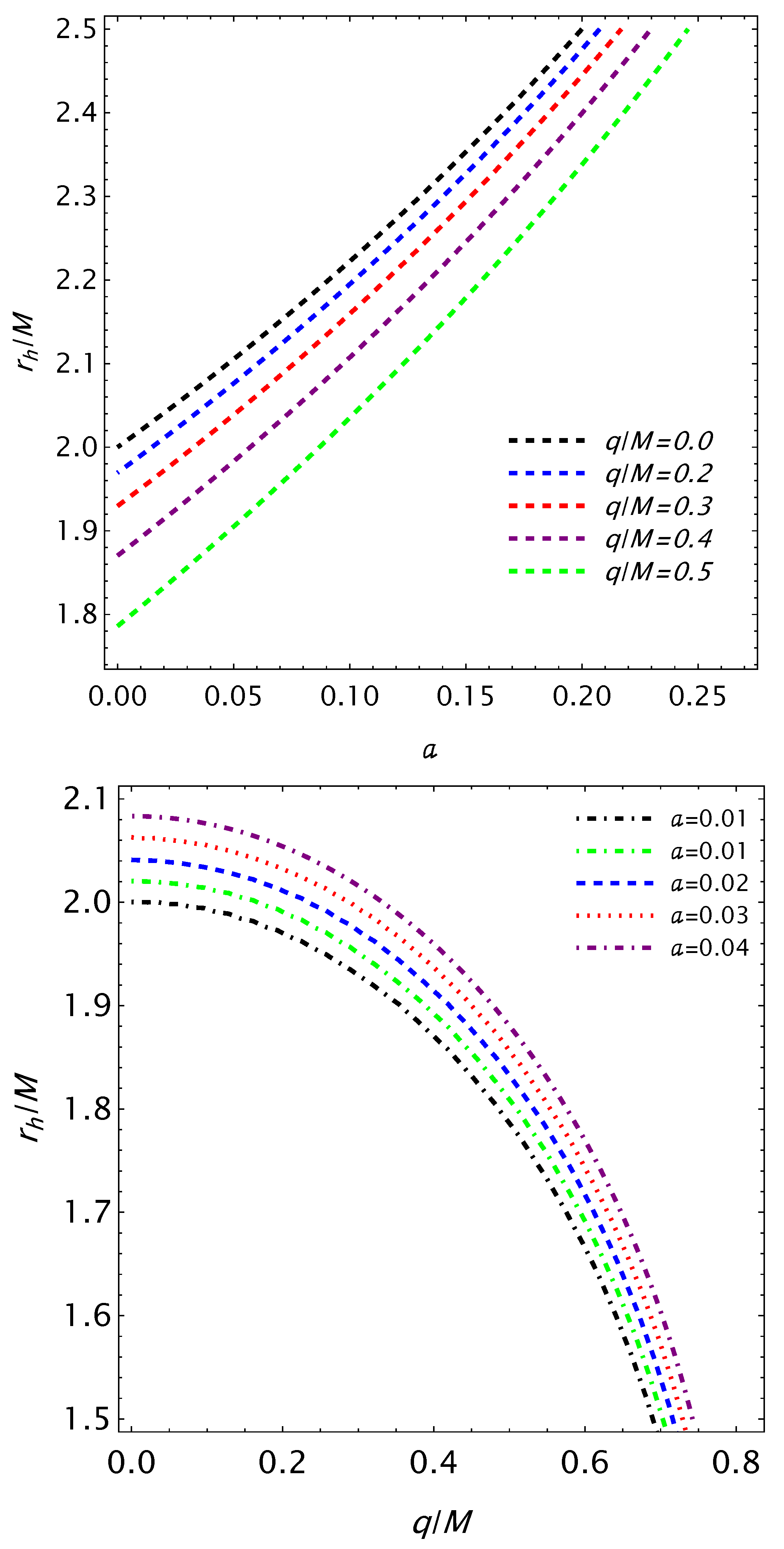
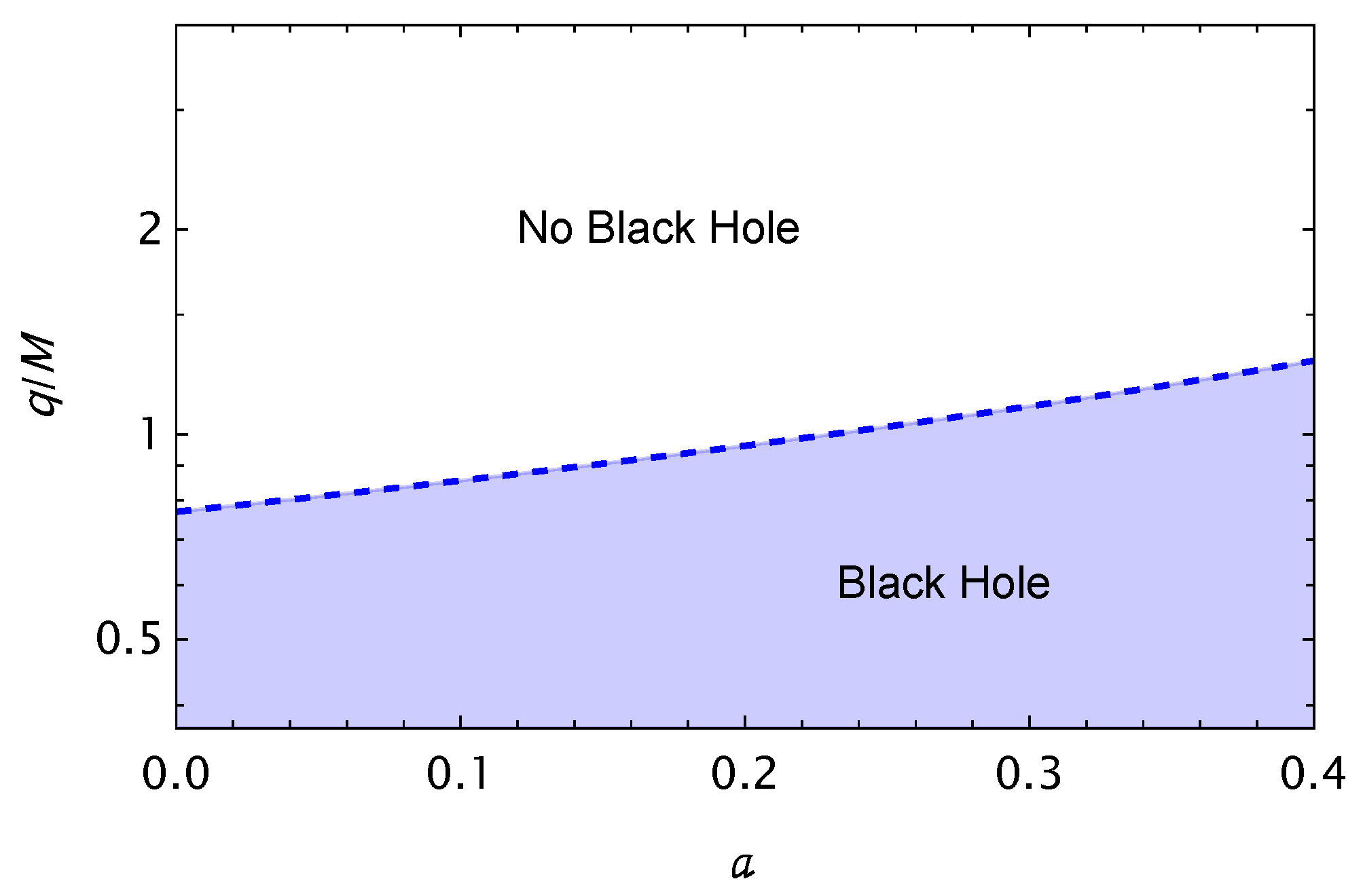
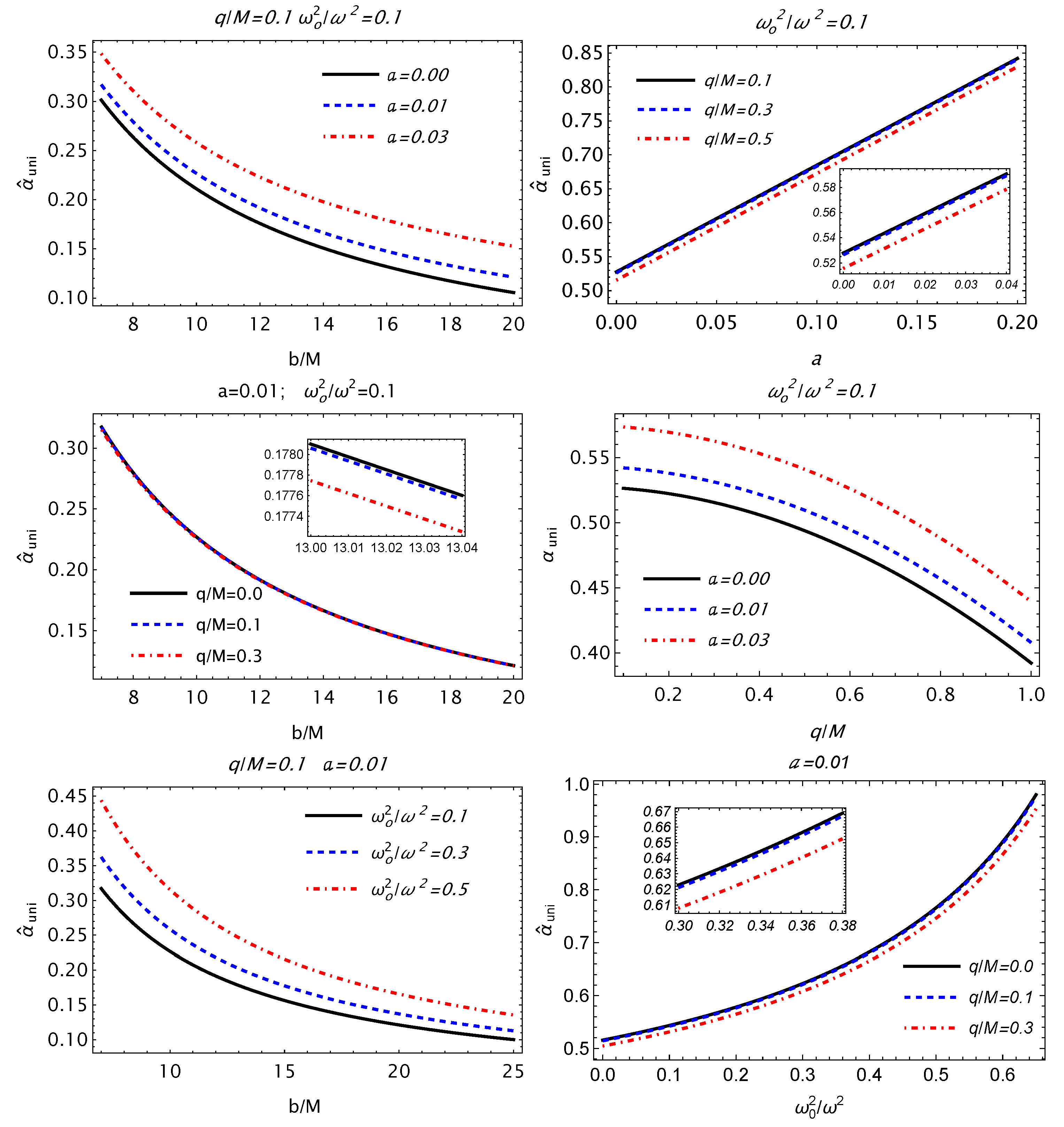
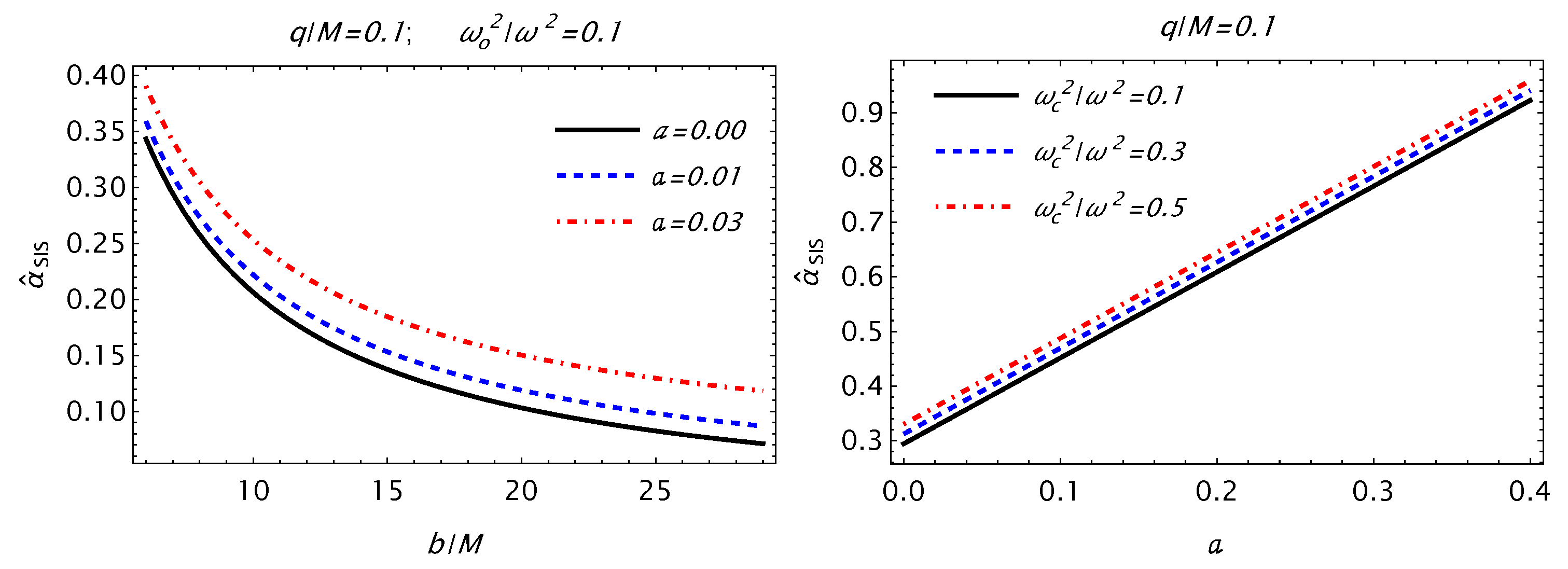
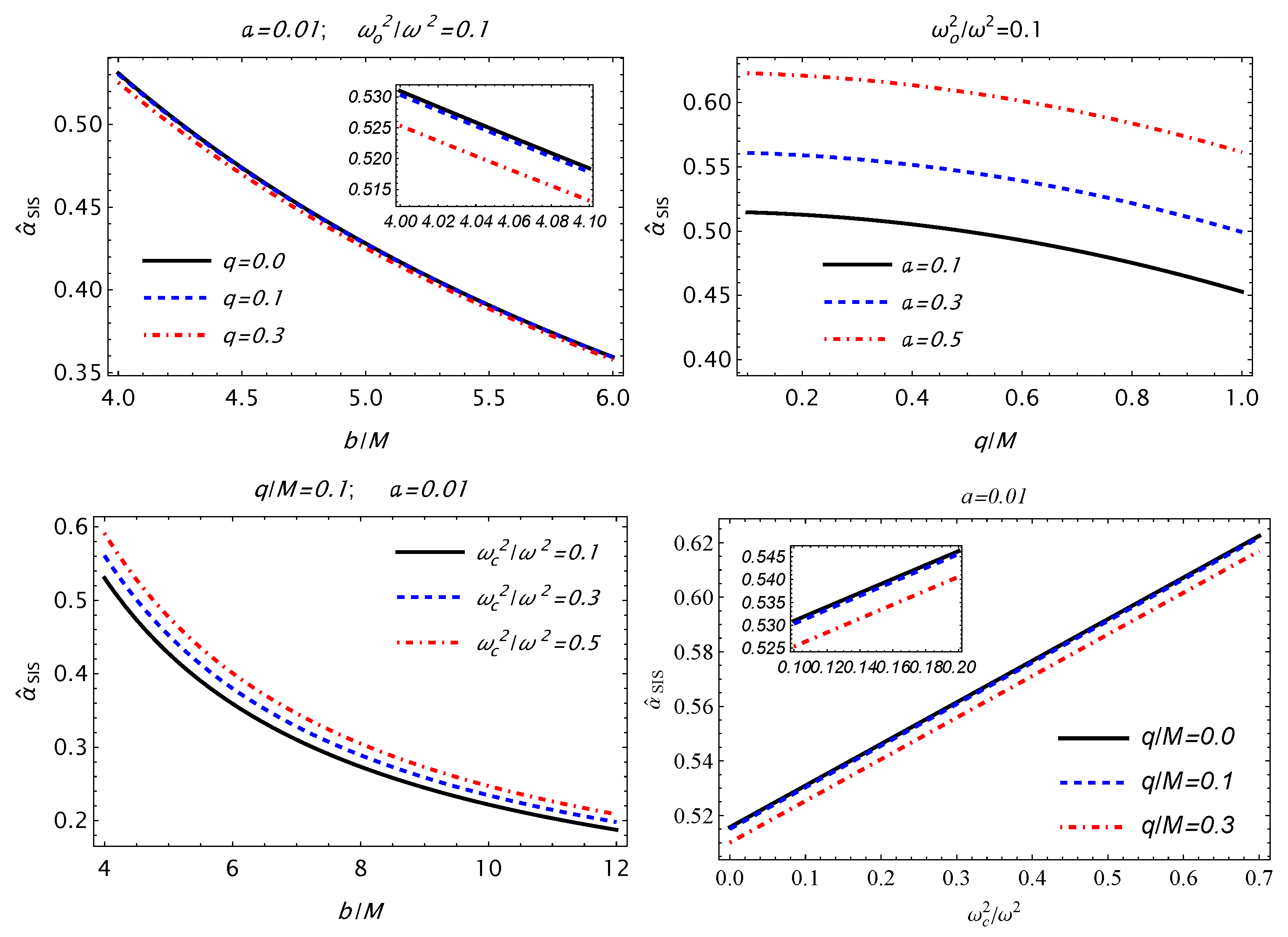
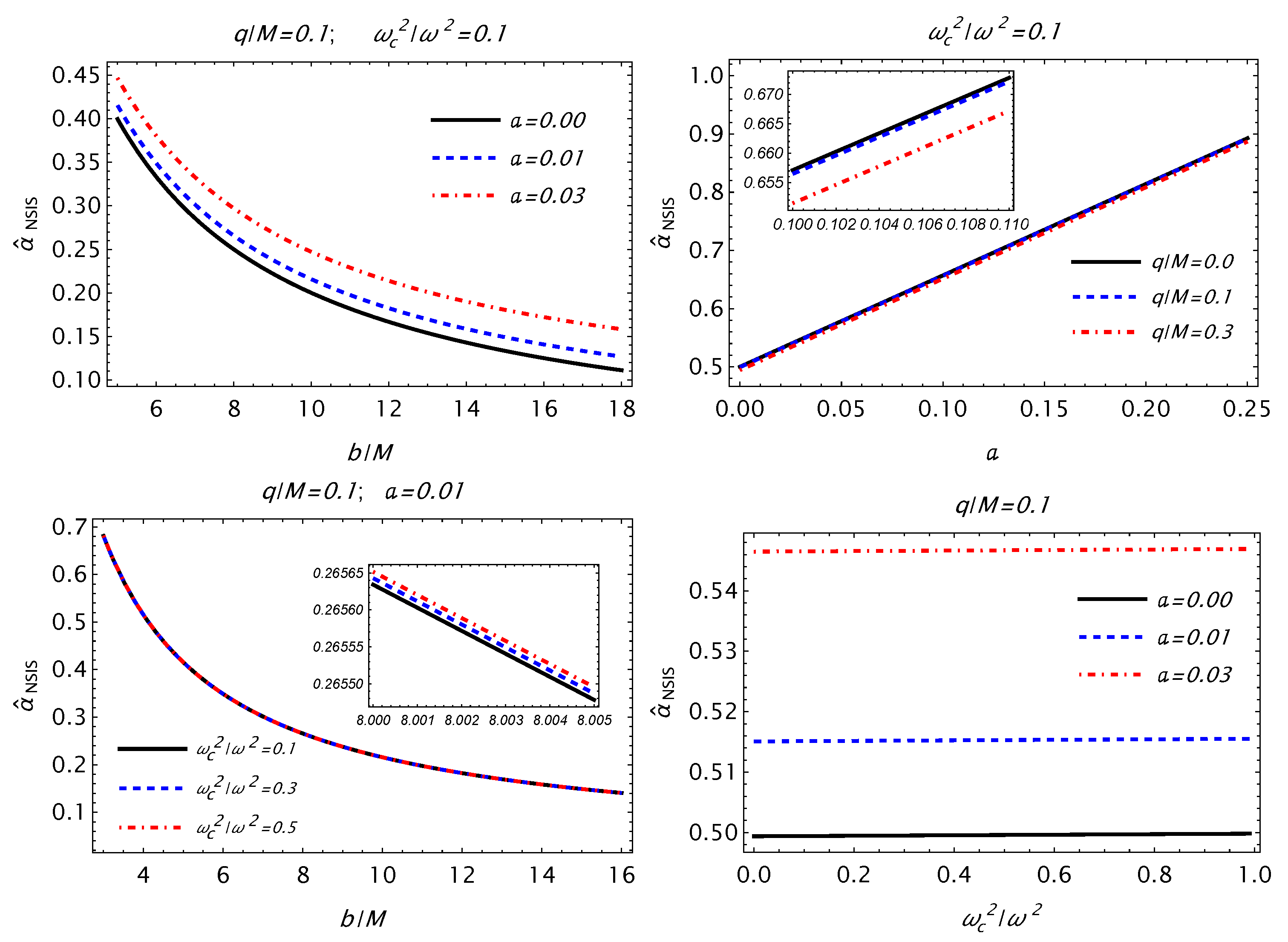



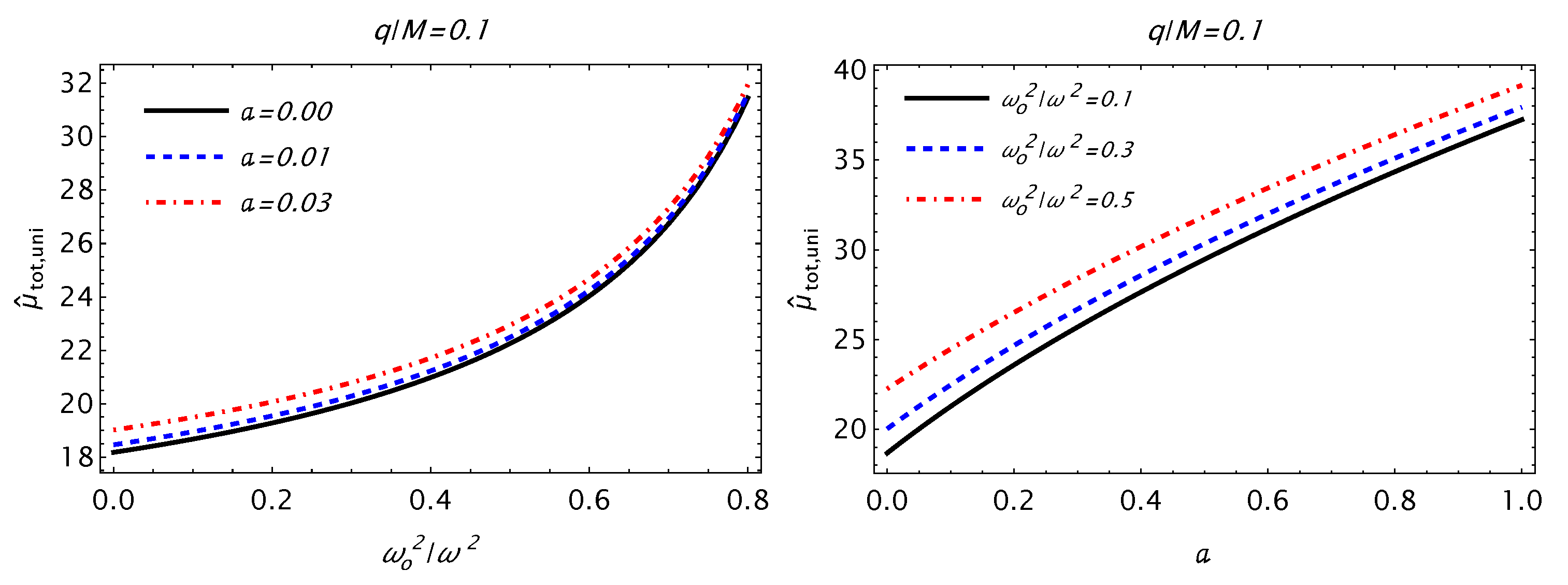


Disclaimer/Publisher’s Note: The statements, opinions and data contained in all publications are solely those of the individual author(s) and contributor(s) and not of MDPI and/or the editor(s). MDPI and/or the editor(s) disclaim responsibility for any injury to people or property resulting from any ideas, methods, instructions or products referred to in the content. |
© 2023 by the authors. Licensee MDPI, Basel, Switzerland. This article is an open access article distributed under the terms and conditions of the Creative Commons Attribution (CC BY) license (https://creativecommons.org/licenses/by/4.0/).
Share and Cite
Atamurotov, F.; Alibekov, H.; Abdujabbarov, A.; Mustafa, G.; Aripov, M.M. Weak Gravitational Lensing around Bardeen Black Hole with a String Cloud in the Presence of Plasma. Symmetry 2023, 15, 848. https://doi.org/10.3390/sym15040848
Atamurotov F, Alibekov H, Abdujabbarov A, Mustafa G, Aripov MM. Weak Gravitational Lensing around Bardeen Black Hole with a String Cloud in the Presence of Plasma. Symmetry. 2023; 15(4):848. https://doi.org/10.3390/sym15040848
Chicago/Turabian StyleAtamurotov, Farruh, Husan Alibekov, Ahmadjon Abdujabbarov, Ghulam Mustafa, and Mersaid M. Aripov. 2023. "Weak Gravitational Lensing around Bardeen Black Hole with a String Cloud in the Presence of Plasma" Symmetry 15, no. 4: 848. https://doi.org/10.3390/sym15040848








